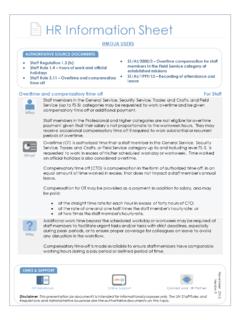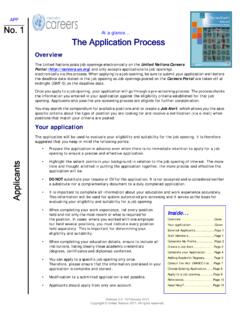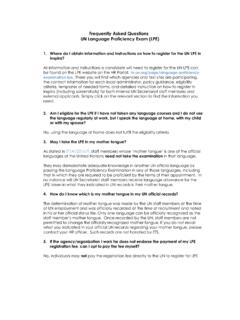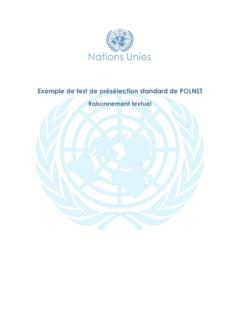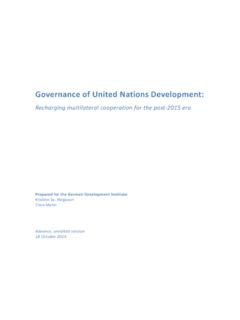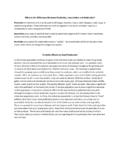Transcription of MALARIA DIAGNOSIS, TREATMENT & PREVENTION: BRIEF …
1 DHMOSH - PUBLIC HEALTH UNIT MALARIA DIAGNOSIS, TREATMENT AND PREVENTION: BRIEF GUIDELINE FOR UN MEDICAL STAFF (APRIL 2019) UNITED NATIONS | DEPARTMENT OF OPERATIONAL SUPPORT 1 MALARIA DIAGNOSIS, TREATMENT & PREVENTION: BRIEF GUIDELINE FOR UN MEDICAL STAFF BACKGROUND MALARIA is a common and life-threatening disease in many tropical and subtropical areas where UN personnel travel to or reside in. This BRIEF guideline provides technical guidance to United Nations medical staff on the clinical diagnosis, TREATMENT and prevention of MALARIA amongst UN personnel. Technical input was provided by the World Health Organization (WHO). This document will be updated as new research and information emerge.
2 DIAGNOSING MALARIA CLINICAL DIAGNOSIS The initial symptoms of MALARIA (most often fever, chills, sweats, headaches, muscle pains, nausea and vomiting) are often non-specific and can also be found in other diseases ( influenza and other common viral infections). Likewise, the physical findings are often non-specific (elevated temperature, sweating and tiredness). However, in severe MALARIA (mostly caused by P. falciparum), the clinical findings of confusion, coma, convulsions, severe anaemia, respiratory difficulties are more specific and may increase the index of suspicion for MALARIA . AFTER RETURN FROM TRAVEL In all patients who recently returned from travel or residence in a MALARIA risk country/area, UN medical staff should always consider the possibility of falciparum MALARIA in all cases of unexplained fever starting at any time between 7 days after the first possible exposure to MALARIA and 3 months (or, rarely, later) after the last possible exposure.
3 LABORATORY DIAGNOSIS For all cases of suspected MALARIA , the health-care provider should conduct an initial workup and arrange for a MALARIA parasitological test either via a quality assured Rapid Diagnostic Tests (RDT) or a microscopic examination of blood smear slide. Either test, or both, can be used as a primary diagnostic tool for the confirmation and management of suspect clinical MALARIA in all epidemiological situations, including areas of low transmission. For microscopy, thick blood smears are more sensitive to detecting the presence of MALARIA parasites while thin smears allow for better species identification.
4 For RDTs, a list of those prequalified by WHO is available at In addition, UN medical staff should also conduct a complete blood count and a routine chemistry panel. In the event that the individual has a positive MALARIA test, these additional tests will be useful in determining whether DHMOSH - PUBLIC HEALTH UNIT MALARIA DIAGNOSIS, TREATMENT AND PREVENTION: BRIEF GUIDELINE FOR UN MEDICAL STAFF (APRIL 2019) 2 the patient has uncomplicated or severe manifestations of the MALARIA infection. Specifically, these tests can detect severe anaemia, hypoglycaemia, renal failure, hyperbilirubinemia, and acid-base disturbances. TREATMENT OF MALARIA MALARIA can be a severe, potentially fatal disease (especially when caused by P.)
5 Falciparum), and TREATMENT should be initiated as soon as possible. If you clinically suspect a diagnosis of MALARIA , and the lab result of the MALARIA test is not available for more than 2 hours, TREATMENT of MALARIA should be started presumptively based on the probability that the illness is MALARIA , and reviewed later based on the test results. Please note that if the patient has signs and symptoms of severe MALARIA , presumptive TREATMENT should be initiated IMMEDIATELY regardless of laboratory test results. UNCOMPLICATED P. FALCIPARUM MALARIA Adults with uncomplicated P. falciparum MALARIA should be treated with one of the following recommended artemisinin-based combination therapies (ACT) for 3 days.
6 The choice of ACT is based on the local parasite resistance profile: Artemether 80 mg + lumefantrine 480 mg, twice daily for 3 days Artesunate 200 mg + amodiaquine 540 mg (ASAQ), once daily for 3 days Artesunate 200 mg + mefloquine 440 mg, once daily for 3 days Dihydroartemisinin + piperauine If 60 - 80 kg: Dihydroartemisinin 160 mg + piperaquine 1280 mg, once daily for 3 days If 80+ kg: Dihydroartemisinin 200 mg + piperaquine 1600 mg, once daily for 3 days UNCOMPLICATED P. VIVAX, P. OVALE, P. MALARIAE OR P. KNOWLESI MALARIA If the MALARIA species is not known, treat as uncomplicated P. falciparum MALARIA . In areas with chloroquine-susceptible infections, treat uncomplicated P.
7 Vivax, P. ovale, P. malariae, or P. knowlesi with either chloroquine or ACT. In areas with chloroquine-resistant infections, treat uncomplicated P. vivax, P. ovale, P. malariae or P. knowlesi MALARIA with ACT. Prevent relapse in P. vivax or P. ovale MALARIA with a 14-day course of primaquine at 30 mg daily (except in pregnant women, women breastfeeding infants less than 6 months, and in G6PD deficient individuals). In people with G6PD deficiency, consider giving primaquine base at 45 mg once a week for 8 weeks, with close medical supervision for potential primaquine-induced haemolysis. UNCOMPLICATED MALARIA IN PREGNANCY Artemisinin combination treatments should be used to treat MALARIA in pregnant women.
8 The combination artesunate + sulfadoxine/pyrimethamine (SP) should not be given in the first trimester because SP is contraindicated in this period of pregnancy. To prevent relapse in pregnant and breastfeeding women with P. vivax or P. ovale, consider weekly prophylaxis with 300 mg chloroquine base followed by primaquine 30 mg daily for 14 days after pregnancy and breastfeeding is completed. DHMOSH - PUBLIC HEALTH UNIT MALARIA DIAGNOSIS, TREATMENT AND PREVENTION: BRIEF GUIDELINE FOR UN MEDICAL STAFF (APRIL 2019) 3 SEVERE MALARIA Severe MALARIA is defined as confirmed MALARIA with at least one of the following: impaired consciousness, prostration, multiple convulsions, respiratory distress, shock, severe anaemia, significant bleeding, jaundice, hypoglycaemia, acute renal injury, or acidosis.
9 Treat patients with severe MALARIA with intravenous or intramuscular artesunate for at least 24 hours until they can tolerate oral medication. For adults, artesunate at should be administered parenterally at the time of admission (0 h), then at 12 h and 24 h, and once a day afterwards until the patient is able to tolerate oral therapy. Parenteral TREATMENT , once started, must be continued for at least 24 hours regardless of the ability of the patient to tolerate oral medication. Once patient has completed parenteral TREATMENT of artesunate, complete MALARIA TREATMENT with 3 days of ACT. If artesunate is not available, use artemether in preference to quinine for treating severe MALARIA .
10 In children, given the possibility of concomitant bacterial infection, parenteral antibiotics should be administered alongside antimalarials until bacterial infection has been ruled out. PERSISTENT SYMPTOMS For patients with recurrent fevers and symptoms of uncomplicated MALARIA developing within 4 weeks after laboratory confirmation of diagnosis of MALARIA , verify completion of effective antimalarial TREATMENT course. If initial TREATMENT was not properly completed, restart the same TREATMENT . If the antimalarial TREATMENT was completed, check blood film slide for persistent MALARIA . If blood smear remains positive or slide microscopy is not available, treat with second-line antimalarial TREATMENT .

